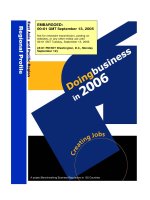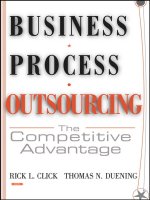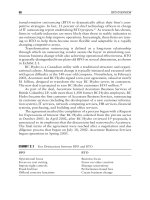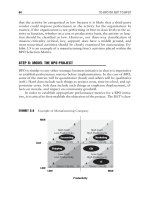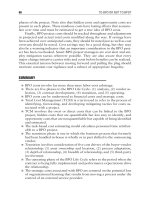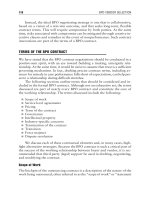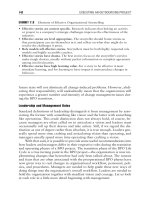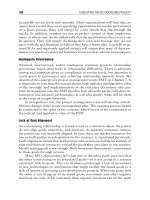Business economics 1st mankiw taylor and ashwin
Bạn đang xem bản rút gọn của tài liệu. Xem và tải ngay bản đầy đủ của tài liệu tại đây (25.29 MB, 585 trang )
www.downloadslide.com
H_HTitlePagecase_HTitlePage
www.downloadslide.com
BUSINESS ECONOMICS
N. Gregory Mankiw, Mark P. Taylor
and Andrew Ashwin
Australia • Brazil • Japan • Korea • Mexico • Singapore • Spain • United Kingdom • United States
H_alloffcase_alloff
www.downloadslide.com
Business Economics, 1st Edition
N. Gregory Mankiw, Mark P. Taylor,
and Andrew Ashwin
Publishing Director: Linden Harris
Publisher: Andrew Ashwin
Editorial Assistant: Lauren Darby
Production Editor: Alison Cooke
Production Controller: Eyvett Davis
Marketing Manager: Anne Renton
Typesetter: MPS Limited
Cover design: Adam Renvoize
© 2013, Cengage Learning EMEA
ALL RIGHTS RESERVED. No part of this work covered by the copyright
herein may be reproduced, transmitted, stored or used in any form or by
any means graphic, electronic, or mechanical, including but not limited to
photocopying, recording, scanning, digitizing, taping, Web distribution,
information networks, or information storage and retrieval systems, except
as permitted under Section 107 or 108 of the 1976 United States Copyright
Act, or applicable copyright law of another jurisdiction, without the prior
written permission of the publisher.
While the publisher has taken all reasonable care in the preparation of this
book, the publisher makes no representation, express or implied, with regard
to the accuracy of the information contained in this book and cannot accept any
legal responsibility or liability for any errors or omissions from the book
or the consequences thereof.
Products and services that are referred to in this book may be either
trademarks and/or registered trademarks of their respective owners. The
publishers and author/s make no claim to these trademarks. The publisher
does not endorse, and accepts no responsibility or liability for, incorrect or
defamatory content contained in hyperlinked material.
For product information and technology assistance,
please contact
For permission to use material from this text or product,
and for permission queries.
This work is adapted from Economics, 2nd edition by N. Gregory Mankiw and
Mark P. Taylor published by Cengage Learning EMEA © 2011.
British Library Cataloguing-in-Publication Data
A catalogue record for this book is available from the British Library.
ISBN: 978-1-4080-6981-3
Cengage Learning EMEA
Cheriton House, North Way, Andover, Hampshire, SP10 5BE
United Kingdom
Cengage Learning products are represented in Canada by Nelson
Education Ltd.
For your lifelong learning solutions, visit www.cengage.co.uk
Purchase your next print book, e-book or e-chapter at
www.cengagebrain.com
Printed in China by RR Donnelley
1 2 3 4 5 6 7 8 9 10 – 15 14 13
H_BTOCcase_BTOC
www.downloadslide.com
BRIEF CONTENTS
About the Authors viii
Preface ix
Walk Through Tour xiv
Acknowledgements xvii
Supplements xviii
10
11
12
13
PART 5 Microeconomics – Factor
Markets 331
PART 1 The Economic and Business
Environment – Setting the Scene 1
1 What Is Business Economics? 3
2 Economics and Business Decision Making
3 The Business Environment 35
14 Labour Markets 333
15 Financial Markets 361
23
PART 6 Introduction to Macroeconomics
PART 2 Microeconomics – The Market
System 53
4 Supply and Demand: How Markets Work
5 Elasticity and Its Applications 87
55
PART 3 Microeconomics – The Limitations of
Markets 119
6 Market Failure 121
7 The Consumer and Consumer Behaviour
The Firm’s Production Decisions 237
Corporate Strategy and Pricing Policy 255
Market Structures 272
Other Types of Imperfect Competition 301
16 The Macroeconomic Environment 387
17 Aggregate Demand and Aggregate Supply
18 Macroeconomics – Employment and
Unemployment 449
19 Macroeconomics – Inflation and Price
Stability 466
20 Macroeconomics – Fiscal, Monetary and
Supply-Side Policy 490
423
PART 7 Global Business and Economics
150
21 The Global Economy
PART 4 Microeconomics – The Economics of
Firms In Markets 177
8 Business Goals and Behaviour 179
9 Firm Behaviour and the Organization of Industry
385
517
519
Glossary 543
Index 549
208
iii
H_TOCcase_TOC
www.downloadslide.com
CONTENTS
About the Authors viii
Preface ix
Walk Through Tour xiv
Acknowledgements xvii
Supplements xviii
Shareholder value and stakeholders
Conclusion 47
Summary 50
Key concepts 50
Questions for review 50
Problems and applications 51
PART 1
46
PART 2
THE ECONOMIC AND BUSINESS
ENVIRONMENT – SETTING THE
SCENE 1
1 What Is Business Economics?
The ten principles of economics 4
How people and businesses make decisions
How people interact 11
How the economy as a whole works 15
Conclusion 20
Summary 21
Key concepts 21
Questions for review 21
Problems and applications 21
3
MICROECONOMICS – THE MARKET
SYSTEM 53
4 Supply and Demand: How Markets
Work 55
The market forces of supply and demand
Markets and competition 56
Supply 58
Demand 63
Demand and supply together 70
How prices allocate resources 82
Summary 84
Key concepts 84
Questions for review 84
Problems and applications 85
4
56
2 Economics and Business Decision
Making 23
5 Elasticity and Its Applications
Economics as the science of decision making
Business decision making 27
Conclusion 32
Summary 34
Key concepts 34
Questions for review 34
Problems and applications 34
Elasticity and its application 88
Price elasticity of supply 88
The price elasticity of demand 96
Other demand elasticities 104
Applications of supply and demand elasticity
Summary 116
Key concepts 117
Questions for review 117
Problems and applications 117
3 The Business Environment
35
What is business – the transformation process
The PESTLE framework 40
iv
24
36
87
110
H_case_TOC
www.downloadslide.com
Contents
8 Business Goals and Behaviour
The goals of firms 180
Financial objectives 186
Break-even analysis 190
Non-financial objectives 200
Summary 206
Key concepts 206
Questions for review 206
Problems and applications 207
PART 3
MICROECONOMICS – THE
LIMITATIONS OF MARKETS
6 Market Failure
121
Introduction 122
Externalities 125
Producer surplus 127
Government business and externalities
Conclusion 146
Summary 147
Key concepts 148
Questions for review 148
Problems and applications 148
134
7 The Consumer and Consumer
Behaviour 150
Introduction 151
Behavioural economics 162
Advertising and branding 165
Brand names 168
Asymmetric information 170
Conclusion 173
Summary 175
Key concepts 175
Questions for review 175
Problems and applications 176
PART 4
119
9 Firm Behaviour and the Organization
of Industry 208
The costs of production 209
What are costs? 209
Production and costs 212
The various measures of cost 216
Costs in the short run and in the long run
Isoquants and isocosts 226
Conclusion 232
Summary 234
Key concepts 234
Questions for review 234
Problems and applications 235
222
1 0 The Firm’s Production Decisions
Introduction 238
The supply curve in a competitive market 246
Conclusion: Behind the supply curve 251
Summary 253
Key concepts 253
Questions for review 253
Problems and applications 254
1 1 Corporate Strategy and Pricing
Policy 255
Introduction 256
Business strategy 256
Pricing strategies 263
Summary 270
Key concepts 270
Questions for review 270
Problems and applications
271
1 2 Market Structures
MICROECONOMICS – THE
ECONOMICS OF FIRMS IN
MARKETS 177
179
272
Introduction 273
Imperfect competition 273
Monopoly 275
How monopolies make production and pricing
decisions 278
The welfare cost of monopoly 285
237
v
H_case_TOC
www.downloadslide.com
vi
Contents
Price discrimination 288
Public policy towards monopolies 292
Conclusion: The prevalence of monopoly
Summary 298
Key concepts 298
Questions for review 298
Problems and applications 299
1 5 Financial Markets
Introduction 362
Financial institutions in the economy 362
Measuring the time value of money 367
Managing risk 368
Asset valuation 372
Savings and investments in the national income
accounts 373
Conclusion 379
Summary 381
Key concepts 382
Questions for review 382
Problems and applications 382
296
1 3 Other Types of Imperfect
Competition 301
Introduction 302
Competition with differentiated products 303
Oligopoly 308
Markets with only a few dominant sellers 308
Game theory and the economics of competition
Public policies toward oligopolies 322
Conclusion 325
Summary 327
Key concepts 327
Questions for review 327
Problems and applications 328
361
314
PART 6
INTRODUCTION TO
MACROECONOMICS
PART 5
385
1 6 The Macroeconomic Environment
MICROECONOMICS – FACTOR
MARKETS 331
1 4 Labour Markets
333
The markets for the factors of production 334
The demand for labour 334
The supply of labour 340
Equilibrium in the labour market 341
The other factors of production: Land and capital
Earnings and discrimination 349
The economics of discrimination 352
Conclusion 356
Summary 358
Key concepts 358
Questions for review 358
Problems and applications 359
347
387
Introduction 388
The economy’s income and expenditure 389
The measurement of gross domestic product 390
The components of GDP 392
Real versus nominal GDP 394
Measuring the cost of living 396
The consumer prices index 397
Production and growth 401
Economic growth and public policy 402
Unemployment 405
Specialization and trade 409
Open-economy macroeconomics: Basic concepts 410
The prices for international transactions: Real and
nominal exchange rates 414
A first theory of exchange rate determination: Purchasing
power parity 416
Conclusion 419
Summary 420
Key concepts 421
Questions for review 421
Problems and applications 421
H_disablecase_disable
www.downloadslide.com
Contents
vii
1 7 Aggregate Demand and Aggregate
Supply 423
2 0 Macroeconomics – Fiscal, Monetary
and Supply-Side Policy 490
Introduction 424
Three key facts about economic fluctuations 424
Explaining short-run economic fluctuations 425
The aggregate demand curve 428
The aggregate supply curve 433
Two causes of economic fluctuations 440
Conclusion 445
Summary 446
Key concepts 447
Questions for review 447
Problems and applications 447
Monetary policy, fiscal policy and supply-side policy 491
Monetary policy 491
Fiscal policy 496
Supply-side policies 502
How monetary policy influences aggregate demand 506
How fiscal policy influences aggregate demand 511
Conclusion 513
Summary 514
Key concepts 515
Questions for review 515
Problems and applications 515
1 8 Macroeconomics – Employment
and Unemployment 449
Introduction 450
Identifying unemployment 450
Job search 453
Minimum wage laws 457
Unions and collective bargaining 458
The theory of efficiency wages 460
Conclusion 463
Summary 464
Key concepts 464
Questions for review 464
Problems and applications 465
1 9 Macroeconomics – Inflation and
Price Stability 466
Money growth and inflation 467
The classical theory of inflation 467
The costs of inflation 470
Inflation and unemployment 474
The Phillips curve 474
The role of expectations 477
The role of supply shocks 482
The cost of reducing inflation 483
Conclusion 486
Summary 488
Key concepts 488
Questions for review 488
Problems and applications 489
PART 7
GLOBAL BUSINESS AND
ECONOMICS 517
2 1 The Global Economy
519
Business in emerging markets 520
The Single European Market and the euro 524
Common currency areas and European monetary
union 526
Fiscal policy and common currency areas 530
Outsourcing 535
Global business, culture and ethics 536
Conclusion 538
Summary 540
Key concepts 541
Questions for review 541
Problems and applications 541
Glossary 543
Index 549
H_Autcase_Aut
www.downloadslide.com
ABOUT THE AUTHORS
N. GREGORY MANKIW is Professor of Economics at Harvard University. As a student,
he studied economics at Princeton University and the Massachusetts Institute of Technology. As a teacher he has taught macroeconomics, microeconomics, statistics and principles
of economics. Professor Mankiw is a prolific writer and a regular participant in academic
and policy debates. In addition to his teaching, research and writing, Professor Mankiw
has been a research associate of the National Bureau of Economic Research, an advisor to
the Federal Reserve Bank of Boston and the Congressional Budget Office. From 2003 to
2005, he served as chairman of the US President’s Council of Economic Advisors. Professor Mankiw lives in Wellesley, Massachusetts, with his wife Deborah, their three children
and their border terrier Tobin.
MARK P. TAYLOR is Dean of Warwick Business School at the University of
Warwick and Professor of International Finance. He obtained his first degree in philosophy, politics and economics from Oxford University and his master’s degree in economics
from London University, from where he also holds a doctorate in economics and international finance. Professor Taylor has taught economics and finance at various universities
(including Oxford, Warwick and New York) and at various levels (including principles
courses, advanced undergraduate and advanced postgraduate courses). He has also worked
as a senior economist at the International Monetary Fund and at the Bank of England and,
before becoming Dean of Warwick Business School, was a managing director at BlackRock, the world’s largest financial asset manager, where he worked on international asset
allocation based on macroeconomic analysis. His research has been extensively published
in scholarly journals and he is today one of the most highly cited economists in the world.
Professor Taylor lives with his family in a 15th century farmhouse near Stratford upon
Avon, Warwickshire, where he collects clocks and keeps bees.
ANDREW ASHWIN has over 20 years experience as a teacher of economics. He has an
MBA and is currently researching for a Ph.D. investigating assessment and the notion of
threshold concepts in economics. Andrew is an experienced author writing a number of
texts for students at different levels, journal publications related to his Ph.D. research and
has a recently published a text on the business environment for undergraduates with
Dr Phil Kelly. Andrew was Chair of Examiners for a major awarding body in England
and Wales for business and economics and is Editor of the Economics, Business and
Enterprise Association (EBEA) journal. Andrew also acts as a consultant to the qualifications regulator in England and Wales and is pursuing Chartered Assessor status with the
Chartered Institute of Educational Assessors. Andrew lives in Rutland with his wife Sue
and their twin sons Alex and Johnny.
viii
H_Prefacecase_Preface
www.downloadslide.com
PREFACE
How much of business is economics and how much of economics is business? This is a
difficult question to answer but perhaps what is at the heart of both is decision-making.
This book is about decision making. Alfred Marshall, the great 19th-century British
economist, in his textbook, Principles of Economics published in 1890 wrote: ‘Economics
is a study of mankind in the ordinary business of life.’ For many people the ordinary
business of life is interwoven with relationships with business. Every single day, billions
of people around the world make decisions. When we make decisions we are being economist. A great proportion of these decisions are made by people in the context of their
work which in turn is part of business. So Business and Economics are very closely
linked. So wrote.
A study of economics in a business context will help you understand the world in
which you live. There are many questions about businesses and the economy that
might spark your curiosity. Why do airlines charge less for a return ticket if the traveller
stays over a Saturday night? Why are movie businesses prepared to pay some actors
extremely large sums to star in films whilst others struggle to even get a bit part? Why
are living standards so meagre in many African countries? Why do some countries have
high rates of inflation while others have stable prices? Why do businesses produce many
products that are so similar – surely they succeed only in cannibalising their market?
Why is it so important to have a better understanding of how consumers behave? Why
have some European countries adopted a common currency? These are just a few of the
questions that a course in Business Economics will help you answer.
The second reason to study Business Economics is that it will make you a more astute
participant in the economy and in business. As you go about your life, you make many
economic decisions. While you are a student, you decide how many years to stay in fulltime education. When you have completed your degree you will have to decide on a
career path and (which may be difficult despite being highly qualified) find a job. Once
you take a job, you decide how much of your income to spend, how much to save and
how to invest your savings. In your daily work you will have to make many decisions
and respond to an ever-changing environment. One day you may find yourself running
your own small business or a large firm, and you will decide what prices to charge for
your products and what products to offer for sale. The insights developed in the coming
chapters will give you a new perspective on how best to make these decisions.
A study of Business Economics will give you a better understanding of the potential
and limits of economic policy and how such policy can influence business behaviour. In
your business career you may find yourself asking various questions about economics.
What are the burdens associated with alternative forms of taxation? What are the effects
of free trade with other countries? To what extent do businesses have a responsibility to
protect the environment? How does the government budget deficit affect the economy
and thus your business?
A study of Business Economics will go some way towards helping you make more
sense of the world, your place in it and how business is affected and behaves as a
consequence.
FOR WHOM IS THIS BOOK WRITTEN?
The book has been written with the non-specialist economist in mind but who has to
embark on a course of study in economics as part of a degree in Business. Your degree
might be Business Economics, it might be Business Management or it might be Sports
ix
H_case_Preface
www.downloadslide.com
x
Preface
Coaching and Management. An increasing number of degree courses will include some
coverage of economic principles and this book is designed for just such courses. We have
tried to put ourselves in the position of someone seeing economics for the first time and
not necessarily looking forward to the prospect. Our goal has been to emphasize the
material that students should and do find interesting about the study of the economy
and business.
One result is that this book is briefer than many books used to introduce students to
economics. Throughout this book we have tried to return to applications and policy
questions as often as possible. All the chapters include case studies illustrating how the
principles of economics are applied. In addition, ‘In the News’ boxes offer highlights
from news events showing how economic ideas shed light on current issues facing
business and society along with questions to help you apply your knowledge to new
contexts – a vitally important part of learning.
HOW IS THIS BOOK ORGANIZED?
In deciding what topics to include in the book we started with the typical course structures at universities offering some sort of Business Economics modules as part of a
degree programme. Some lecturers will choose to study topics is a slightly different
order but our thinking was to try and present what we felt was a logical way of presenting an introduction to economics as it applies to a business context.
Introductory Material
Chapter 1, ‘What is Business Economics’, sets the scene by introducing students to the
economists’ view of the world through the ‘Ten Principles of Economics’ and business
decision making. It previews some of the big ideas that recur throughout economics,
such as opportunity cost, marginal decision making, the role of incentives, the gains
from trade, and the efficiency of market allocations. Throughout the book, we refer regularly to the Ten Principles of Economics introduced in Chapter 1 to remind students
that these ideas are the foundation for all economics. Chapter 2, ‘Economics and
Business Decision Making’, explores decision making in more detail and includes a discussion about a crucial part of any business – recruiting and retaining customers.
Chapter 3, ‘The Business Environment’, presents an overview of what we mean by business activity, how businesses transform inputs into outputs, the meaning of adding value
and the internal and external environment within which businesses have to operate.
We have looked at this environment through what is called the PESTLE framework –
political, economic, social, technological and environmental.
Microeconomics – The Market System
The next two chapters introduce the market system through looking at the basic tools of
supply and demand. Chapter 4, ‘The Market Forces of Supply and Demand’, develops
the supply curve, the demand curve and the notion of market equilibrium. Chapter 5,
‘Elasticity and Its Application’, introduces the concept of elasticity and uses it to analyze
events in three different markets.
Microeconomics – The Limitations of the Market System
Whilst many economies work based on market systems, they do, like most things, have
their limitations. The next two chapters use the tools developed to look at Market Failure
H_case_Preface
www.downloadslide.com
Preface
and The Consumer and Consumer Behaviour. You will learn that the costs and benefits
of market activity are not always taken into account by decision makers and as a result
the allocation of resources is less than efficient. In Chapter 7 you will learn that consumers (both businesses and individuals) do not always behave rationally and this can also
lead to a less than efficient resource allocation. An understanding of consumer behaviour
is an important aspect of business – after all, if we do not understand how the individuals and businesses we want to sell products to then businesses will suffer and be
more likely to fail.
Microeconomics – The Economics of Firms in Markets
Part 4 includes 6 chapters devoted to understanding and analysing the actions and
behaviour of firms. Chapter 8 looks at business goals and behaviour to get an understanding of why businesses exist, what they aim to do and how changes to business
goals can lead to different behaviour. Chapter 9 builds on some of the concepts introduced in Chapter 8 and covers firms’ costs and revenues in the short and long run.
Chapter 10 presents a model of the firm in equilibrium and how production decisions
are made in competitive conditions. Chapter 11 follows up on this by looking at pricing
decisions and an introduction to business strategy before Chapter 12 covers the effect on
business behaviour of operating in different market structures such as when a firm has
monopoly power. This enables you to understand how degrees of market power influence the way firms behave. Chapter 13 follows on by looking at other forms of market
structure including monopolistic competition (not to be confused with monopoly) and
oligopoly – competition amongst the few.
Microeconomics – Factor Markets
We complete our look at microeconomics with Part 5 which looks at the markets for
labour and capital, two key components of factor inputs for a business. Chapter 14,
emphasizes the link between factor prices and marginal productivity and discusses the
determinants of equilibrium wages. Chapter 15 introduces important concepts in the
theory and practice of financial markets including the time value of money, how asset
prices are determined and the supply and demand for loanable funds.
Macroeconomics
The next five chapters cover the macroeconomic environment in which firms have to
operate. Our overall approach to teaching macroeconomics is to examine the economy
in the long run (when prices are flexible) before examining the economy in the short
run (when prices are sticky). We believe that this organization simplifies learning macroeconomics for several reasons. First, the classical assumption of price flexibility is more
closely linked to the basic lessons of supply and demand, to which you have already been
introduced. Secondly, the classical dichotomy allows the study of the long run to be broken up into several, easily digested pieces. Thirdly, because the business cycle represents
a transitory deviation from the economy’s long-run growth path, studying the transitory
deviations is more natural after the long-run equilibrium is understood. Fourthly, the
macroeconomic theory of the short run is more controversial among economists than
the macroeconomic theory of the long run. For these reasons, most upper-level courses
in macroeconomics now follow this long-run-before-short-run approach; our goal is to
offer introductory students the same advantage. There would be nothing to stop lecturers
who prefer to approach the short run first from so doing – the book is flexible enough to
allow this approach to be adopted.
xi
H_case_Preface
www.downloadslide.com
xii
Preface
Chapter 16, introduces some basic macroeconomic concepts including a discussion of
the meaning of gross domestic product and related statistics from the national income
accounts, the measurement and use of the consumer price indices, real and nominal
interest rates, trade and exchange rates. These concepts are developed in the next four
chapters which look in more detail at aggregate demand and supply, employment and
unemployment, inflation and price stability and macroeconomic policy.
Global Business and Economics
We complete our journey through Business Economics by looking at the impact of doing
business globally. Increasingly firms are involved in global trade and having some understanding of emerging markets, different business cultures and the European Union and
the single market provides a foundation for what will be likely to be further study as you
progress through your degree.
LEARNING TOOLS
The purpose of this book is to help students learn the fundamental lessons of economics
and to apply these lessons to a business context. Towards that end, we have used various
learning tools that recur throughout the book.
• Case Studies. Economic theory is useful and interesting only if it can be applied to
understanding actual events and policies. This book, therefore, contains numerous
case studies that apply the theory that has just been developed in a business context.
• ‘In the News’ boxes. One benefit that students gain from studying economics is a new
perspective and greater understanding about news from around the world. To highlight this benefit, we have incorporated discussions of news events including excerpts
from newspaper articles from around Europe, the Middle East, Africa and India.
These articles, together with our brief introductions, show how basic economic theory
can be applied and raise important questions for discussion in business. To help further develop application skills we have included some questions at the end which can
either be used as practice for self-study or as the basis for seminar or tutorial
discussion.
• ‘FYI’ Boxes. These boxes provide additional material ‘for your information’. Some of
them offer a glimpse into the history of economic thought. Others clarify technical
issues. Still others discuss supplementary topics that instructors might choose either
to discuss or skip in their lectures but which students should find useful in supplementing their knowledge and understanding.
• Definitions of key concepts. When key concepts are introduced in the chapter, they are
presented in bold typeface. In addition, their definitions are placed in the margins.
This treatment should aid students in learning and reviewing the material.
• Pitfall Preventions. The authors have used their collective teaching wisdom to outline
areas where students make frequent mistakes and which can be a cause of confusion.
The Pitfall Prevention boxes alert students to the potential for these mistakes.
• Jeopardy Problems. These are problems designed to help you think as an economist.
You will be given end- points or solutions and you have to think through the different
ways in which the solutions or end-point given might have been arrived at using your
knowledge of economics and business.
• What if…? Questions designed to get you thinking about different scenarios in business and economics.
H_disablecase_disable
www.downloadslide.com
Preface
• Quick quizzes. After most major sections, students are offered a ‘quick quiz’ to check
their comprehension of what they have just learned. If students cannot readily answer
these quizzes, they should stop and reread material before continuing.
• Chapter summaries. Each chapter ends with a brief summary that reminds you of the
most important lessons that you have just learned. Later in your study it offers an
efficient way to revise for exams.
• List of key concepts. A list of key concepts at the end of each chapter offers you a way
to test your understanding of the new terms that have been introduced.
Page references are included so that you can review the terms you do not understand.
All key terms can also be found in the glossary at the end of the book.
• Questions for review. At the end of each chapter are questions for review that over the
chapter’s primary lessons. You can use these questions to check your comprehension
and to prepare for exams.
• Problems and applications. Each chapter also contains a variety of problems and
applications that ask you to apply the material you have learned. Some instructors
may use these questions for homework assignments. Others may use them as a starting point for classroom discussions.
xiii
H_Walkcase_Walk
www.downloadslide.com
WALK THROUGH TOUR
xiv
Learning Objectives and ’After reading this
chapter you should be able to’ Bullet points appear
at the start of each chapter in order to highlight to the
student chapter’s key ideas
Glossary Terms Key terms relevant to Buisness
Economics are defined throughout the text and also
featured in the glossary at the back of the book.
Case studies are provided throughout the text that
apply the theory that has been developed to
understanding events and policies.
Pitfall Preventions The authors have used their
collective teaching wisdom to outline areas where
students make frequent mistakes and which can be a
cause of confusion. The Pitfall Prevention boxes alert
students to the potential for these mistakes.
H_case_Walk
www.downloadslide.com
Quick quizzes are provided at the end of each section
and allow students to check their comprehension of
what they have just learned.
FYI provides additional material ‘for your information’;
the boxes offer a range of supplementary material,
such as a glimpse into the history of economic
thought, technical issues and current topics that can
be discussed in lectures.
’what if’ boxes Questions designed to get you
thinking about different scenarios in business and
economics.
Jeopardy Problems These are problems designed to
help you think as an economist. You will be given endpoints or solutions and you have to think through the
different ways in which the solutions or end-point
given might have been arrived at using your
knowledge of economics and business.
xv
H_disablecase_disable
www.downloadslide.com
xvi
In the News articles relate key ideas covered in the
chapter to topical news events to highlight the
application of economic ideas and introduce new
angles to consider in topical debates.
Summaries at the end of each chapter remind
students of what they have learned so far, offering a
useful way to review for exams.
Questions for review cover each chapter’s primary
lessons. These can be used to check comprehension
and to prepare for exams.
Problems and applications allow students to apply
the material they have learned within the chapter.
These can also be used for classroom discussions or
homework assignments.
H_Acknowledgmentscase_Acknowledgments
www.downloadslide.com
ACKNOWLEDGEMENTS
The authors would like to thank the following reviewers for their comments:
Andrew Abbott – University of Hull
Dr. Turner Anna – CEU Business School
Emanuele Bracco – Lancaster University
Dr Yu-Fu Chen – Economic Studies, Dundee University
Matthew T. Col – University College Dublin
Gary Cook – University of Liverpool
Dr John Duignan – University of the West of Scotland
Aat van Eeden – Zuyd University of Applied Science
Robert Elliott – University of Birmingham
John Forde – University of Salford
Richard Godfrey – Cardiff School of Management
Marco Gundermann – Cardiff Metropolitan University
Dr. Hala Helmi El Hadidi – British University, Egypt
Juan Garcia Lara – Universidad Carlos III Madrid, Spain
Paul L. Latreille – Swansea University
Dr. Bobby Mackie – University of the West of Scotland
Tim Maxfield – University of Worcester
Natalie Moore – University of Nottingham
Yoko Nagase – Oxford Brookes University
Adel Nemeth – Jacobs University Bremen
Dr Matthew Olczak – Aston University, UK
Quentin Outram – Leeds University Business School
Bruce Philp – Nottingham Business School
Julia Planko – Hogeschool Utrecht
Neil Reaich – Economic, Business and Enterprise Association
Jose R. Sanchez-Fung – Kingston University London, UK
Ulrich Schüle – School of Business FH Mainz-University of Applied sciences
Cemil Selcuk – Cardiff University
Vasilios Sogiakas – University of Glasgow
Nicholas Spearman – University of the Witwatersrand, South Africa
Dr F Steffen – University of Liverpool Management School
Michael Wood – London South Bank University
Dr Michael Wynn-Williams – University of Greenwich
Gaston Yalonetzky – Leeds University Business School
xvii
H_Suppcase_Supp
www.downloadslide.com
SUPPLEMENTS
Cengage Learning offers various digital resources for instructors and students who use this book. These resources are designed
to make teaching the principles of business economics easy for the instructor and learning them easy for the student.
ABOUT THE DIGITAL
RESOURCES
More information about the digital support resources accompanying this book can be found on page xix.
For instructors
Teaching the principles of business economics can be a
demanding job. The supplements designed for the instructor
make the job less difficult.
• Instructor’s Manual – a detailed outline of each chapter
of the text that provides earning objectives, identifies
stumbling blocks that students may face, offers helpful
teaching tips and provides suggested in-classroom activities for more cooperative learning experience. The
Instructor’s Manual also includes solutions to all of the
end-of-chapter exercises, Quick Quizzes, Questions for
Review and Problems and Applications found in the text.
• PowerPoint™ Lecture Slides and Exhibit Slides – Instructors can save valuable time as they prepare for classes
using these fully adaptable comprehensive lecture presentations with integrated graphs, tables, lists and concepts. A
separate exhibit presentation provides instructors with all
of the tables and graphs from the main text.
For students
The supplements designed for the student enrich and support the learning experience, providing excellent revision
tools and further study opportunities.
xviii
• Learning Objectives – listed for each chapter, they help
the student to monitor their understanding and progress
through the book.
• Exhibit Slides – provided in PowerPoint™, the exhibit presentations provide students with animated figures from
the main text.
• Glossary – the full glossary of key terms that appears at
the end of the book in downloadable PDF file.
• Self-test questions - a wide array of different types of
questions, including objective tests, short-answer questions and problems, topical case studies and advance critical thinking questions, providing variety for the student
and testing all areas of their knowledge and skills. The
student can check their work by revealing the correct
answers, where appropriate, providing instant feedback.
OTHER SUPPLEMENTARY
RESOURCES
• Exam View® The computerized test generator software
contains a testbank of questions for each chapter, allowing instructors to create online, paper or local area network (LAN) tests. This product is only available from
your Cengage Learning sales representative.
• Virtual Learning Environment All of the web material is
available in a format that is compatible with virtual learning environments such as Moodle and Blackboard. This
version of the product is only available from your Cengage
Learning sales representative.
H_case_Supp
www.downloadslide.com
H_disablecase_disable
www.downloadslide.com
H_Partcase_Part
www.downloadslide.com
PART 1
THE ECONOMIC AND BUSINESS
ENVIRONMENT – SETTING
THE SCENE
DARREN TURNER/SHUTTERSTOCK
H_alloffcase_alloff
www.downloadslide.com
H_Chaptercase_Chapter
www.downloadslide.com
1
WHAT IS BUSINESS ECONOMICS?
LEARNING OBJECTIVES
In this chapter you will:
After reading this chapter you should be able to:
•
Learn that economics is about the allocation of scarce
resources
•
Define scarcity
•
Explain the classic trade-off between ‘guns and butter’
•
Examine some of the trade-offs that people face
•
•
Learn the meaning of opportunity cost
Add up your particular opportunity cost of attending
university
•
See how to use marginal reasoning when making
decisions
•
Compare the marginal costs and marginal benefits of
continuing to attend school indefinitely
•
Discuss how incentives affect people’s behaviour
•
•
Consider why trade among people or nations can be
good for everyone
Consider how a quadrupling of your tuition payments
would affect your decision to educate yourself
•
Discuss why markets are a good, but not perfect, way to
allocate resources
Explain why specialization and trade improve people’s
choices
•
Give an example of an externality
•
Explain the source of large and persistent inflation
•
•
Learn what determines some trends in the overall
economy
3
H_case_Chapter
www.downloadslide.com
4
Part 1
The Economic and Business Environment – Setting the Scene
THE TEN PRINCIPLES OF ECONOMICS
stakeholder any group or individual
with an interest in a business such as
workers, managers, suppliers, the local
community, customers and owners
scarcity the limited nature of society’s
resources
economics the study of how society
manages its scarce resources
The word ‘economy’ comes from the Greek word oikonomos, which means for ‘one who
manages a household’. At first, this origin might seem peculiar. But, in fact, businesses
and economies have much in common.
A business faces many decisions. It must decide how many people to employ, what
each of those people will do to contribute to the business, how much each employee gets
in return, who should receive a bonus scheme and who should not, how to increase output
per worker, how best to manage costs, when to invest, how much to invest and where best
to get the funds to invest from, what products to produce, what products not to produce,
when to stop producing products, when to expand, when to contract, how best to manage
the sales process and customer relations, whether to be environmentally friendly or
whether to give the impression of being so, how to deal with competitors and whether to
charge a high price or a low price (or one in between). In short, business must allocate
scarce resources among competing uses, taking into account a range of stakeholder wants
and needs. A stakeholder is any group or individual with an interest in a business.
Like businesses, a society faces many decisions. A society must decide what jobs will be
done and who will do them. It needs some people to grow food, other people to make
clothing and still others to design computer software. Once society has allocated people
(as well as land, buildings and machines) to various jobs, it must also allocate the output
of goods and services that they produce. It must decide who will eat caviar and who will
eat potatoes. It must decide who will drive a Ferrari and who will take the bus.
The management of society’s resources is important because resources are scarce.
Scarcity means that society has limited resources and therefore cannot produce all the
goods and services people wish to have. Just as a household cannot give every member
everything he or she wants, a society cannot give every individual the highest standard of
living to which he or she might aspire.
Economics is the study of how society manages its scarce resources. In most societies,
resources are allocated not by a single central planner but through the combined actions of
millions of households and firms. Economists therefore study how people make decisions:
how much they work, what they buy, how much they save and how they invest their savings. Economists also study how people and people in businesses interact with one
another. For instance, they examine how the multitude of buyers and sellers of a good
together determine the price at which the good is sold and the quantity that is sold. Economists analyse forces and trends that affect the economy as a whole, including the growth
in average income, the fraction of the population that cannot find work and the rate at
which prices are rising. Many of the concepts that economists use are also directly applicable and of relevance to businesses. In a sense, economics can be described as the science
of decision making and since businesses all around the world have to make millions of
decisions every day then having some understanding of the process of decision making
and the consequences that might arise from such decision making is important.
Although the study of economics has many facets, the field is unified by several central
ideas, all of which are of direct relevance to business. In the rest of this chapter we look at
Ten Principles of Economics. Don’t worry if you don’t understand them all at first, or if you
don’t find them completely convincing. In the coming chapters we will explore these ideas
more fully. The ten principles are introduced here just to give you an overview of what
economics is all about. You can think of this chapter as a ‘preview of coming attractions’.
HOW PEOPLE AND BUSINESSES
MAKE DECISIONS
We use the term ‘the economy’ on a regular basis but have you ever stopped to think
about what the term really means? Whether we are talking about the economy of a
group of countries such as the European Union or the Middle East, or the economy of
